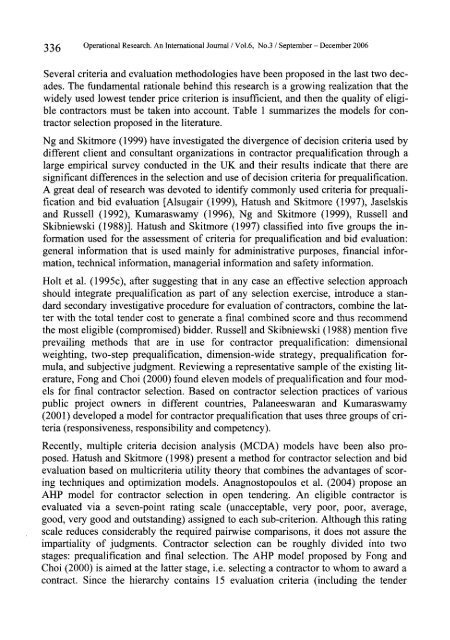An AHP model for construction contractor prequalification
An AHP model for construction contractor prequalification
An AHP model for construction contractor prequalification
You also want an ePaper? Increase the reach of your titles
YUMPU automatically turns print PDFs into web optimized ePapers that Google loves.
336 Operational Research. <strong>An</strong> International Journal / Vol.6, No.3 / September - December 2006<br />
Several criteria and evaluation methodologies have been proposed in the last two dec-<br />
ades. The fundamental rationale behind this research is a growing realization that the<br />
widely used lowest tender price criterion is insufficient, and then the quality of eligi-<br />
ble <strong>contractor</strong>s must be taken into account. Table 1 summarizes the <strong>model</strong>s <strong>for</strong> con-<br />
tractor selection proposed in the literature.<br />
Ng and Skitmore (1999) have investigated the divergence of decision criteria used by<br />
different client and consultant organizations in <strong>contractor</strong> <strong>prequalification</strong> through a<br />
large empirical survey conducted in the UK and their results indicate that there are<br />
significant differences in the selection and use of decision criteria <strong>for</strong> <strong>prequalification</strong>.<br />
A great deal of research was devoted to identify commonly used criteria <strong>for</strong> prequali-<br />
fication and bid evaluation [Alsugair (1999), Hatush and Skitmore (1997), Jaselskis<br />
and Russell (1992), Kumaraswamy (1996), Ng and Skitmore (1999), Russell and<br />
Skibniewski (1988)]. Hatush and Skitmore (1997) classified into five groups the in-<br />
<strong>for</strong>mation used <strong>for</strong> the assessment of criteria <strong>for</strong> <strong>prequalification</strong> and bid evaluation:<br />
general in<strong>for</strong>mation that is used mainly <strong>for</strong> administrative purposes, financial in<strong>for</strong>-<br />
mation, technical in<strong>for</strong>mation, managerial in<strong>for</strong>mation and safety in<strong>for</strong>mation.<br />
Holt et al. (1995c), after suggesting that in any case an effective selection approach<br />
should integrate <strong>prequalification</strong> as part of any selection exercise, introduce a stan-<br />
dard secondary investigative procedure <strong>for</strong> evaluation of <strong>contractor</strong>s, combine the lat-<br />
ter with the total tender cost to generate a final combined score and thus recommend<br />
the most eligible (compromised) bidder. Russell and Skibniewski (1988) mention five<br />
prevailing methods that are in use <strong>for</strong> <strong>contractor</strong> <strong>prequalification</strong>: dimensional<br />
weighting, two-step <strong>prequalification</strong>, dimension-wide strategy, <strong>prequalification</strong> <strong>for</strong>-<br />
mula, and subjective judgment. Reviewing a representative sample of the existing lit-<br />
erature, Fong and Choi (2000) found eleven <strong>model</strong>s of <strong>prequalification</strong> and four mod-<br />
els <strong>for</strong> final <strong>contractor</strong> selection. Based on <strong>contractor</strong> selection practices of various<br />
public project owners in different countries, Palaneeswaran and Kumaraswamy<br />
(2001) developed a <strong>model</strong> <strong>for</strong> <strong>contractor</strong> <strong>prequalification</strong> that uses three groups of cri-<br />
teria (responsiveness, responsibility and competency).<br />
Recently, multiple criteria decision analysis (MCDA) <strong>model</strong>s have been also pro-<br />
posed. Hatush and Skitmore (1998) present a method <strong>for</strong> <strong>contractor</strong> selection and bid<br />
evaluation based on multicriteria utility theory that combines the advantages of scor-<br />
ing techniques and optimization <strong>model</strong>s. <strong>An</strong>agnostopoulos et al. (2004) propose an<br />
<strong>AHP</strong> <strong>model</strong> <strong>for</strong> <strong>contractor</strong> selection in open tendering. <strong>An</strong> eligible <strong>contractor</strong> is<br />
evaluated via a seven-point rating scale (unacceptable, very poor, poor, average,<br />
good, very good and outstanding) assigned to each sub-criterion. Although this rating<br />
scale reduces considerably the required pairwise comparisons, it does not assure the<br />
impartiality of judgments. Contractor selection can be roughly divided into two<br />
stages: <strong>prequalification</strong> and final selection. The <strong>AHP</strong> <strong>model</strong> proposed by Fong and<br />
Choi (2000) is aimed at the latter stage, i.e. selecting a <strong>contractor</strong> to whom to award a<br />
contract. Since the hierarchy contains 15 evaluation criteria (including the tender




